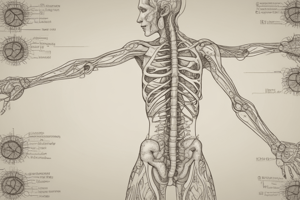Podcast
Questions and Answers
What is the primary reason why cranial nerves are called cranial nerves?
What is the primary reason why cranial nerves are called cranial nerves?
- They are only found in the peripheral nervous system
- They are responsible for transmitting sensory information from the skin
- They emerge from the spinal cord
- They emerge from the brain and pass through foramina or fissures in the skull (correct)
What is the function of afferent nerves?
What is the function of afferent nerves?
- They regulate the autonomic nervous system
- They transmit sensory information from sensory receptors to the brain (correct)
- They produce hormones that regulate the endocrine system
- They transmit motor signals from the brain to skeletal muscles
Which of the following is an example of a special somatic fiber?
Which of the following is an example of a special somatic fiber?
- Smell (correct)
- Vision
- Cutaneous sensation
- Motor signal to skeletal muscle
What is the function of the visceral afferent fiber (GVA)?
What is the function of the visceral afferent fiber (GVA)?
What is the function of the general visceral efferent fiber (GVE)?
What is the function of the general visceral efferent fiber (GVE)?
Which of the following is an example of a cranial nerve fiber that innervates structures derived from somites?
Which of the following is an example of a cranial nerve fiber that innervates structures derived from somites?
What is the classification system used to categorize cranial nerve fibers?
What is the classification system used to categorize cranial nerve fibers?
What is the mnemonic device used to remember the 12 cranial nerves?
What is the mnemonic device used to remember the 12 cranial nerves?
What is the primary function of efferent neurons in the nervous system?
What is the primary function of efferent neurons in the nervous system?
Which part of the brain stem is connected to the cerebellum?
Which part of the brain stem is connected to the cerebellum?
What is the main difference between cranial nerves and spinal nerves?
What is the main difference between cranial nerves and spinal nerves?
What is the function of the hypothalamus in the diencephalon?
What is the function of the hypothalamus in the diencephalon?
Which type of neuron conveys information from tissues and organs into the central nervous system?
Which type of neuron conveys information from tissues and organs into the central nervous system?
What is the term for the division of the nervous system that consists of the brain and spinal cord?
What is the term for the division of the nervous system that consists of the brain and spinal cord?
What is the function of the cerebellum in the brain?
What is the function of the cerebellum in the brain?
What is the main function of the autonomic nervous system?
What is the main function of the autonomic nervous system?
Which cranial nerve is responsible for motor functions to the sternomastoid and trapezius muscles?
Which cranial nerve is responsible for motor functions to the sternomastoid and trapezius muscles?
Which part of the brain is the origin of the trochlear nerve?
Which part of the brain is the origin of the trochlear nerve?
Which nerve is responsible for transmitting visceral sensations from the stomach and small intestine?
Which nerve is responsible for transmitting visceral sensations from the stomach and small intestine?
Which cranial nerve is divided into ophthalmic, maxillary, and mandibular branches?
Which cranial nerve is divided into ophthalmic, maxillary, and mandibular branches?
Which nerve is responsible for transmitting sensory information from the pharynx and palate?
Which nerve is responsible for transmitting sensory information from the pharynx and palate?
Which part of the brain is the attachment site for the olfactory nerve?
Which part of the brain is the attachment site for the olfactory nerve?
Which nerve is responsible for transmitting motor signals to the muscles of the tongue?
Which nerve is responsible for transmitting motor signals to the muscles of the tongue?
Which nerve is responsible for transmitting sensory information from the heart and lungs?
Which nerve is responsible for transmitting sensory information from the heart and lungs?
Flashcards are hidden until you start studying
Study Notes
The Nervous System
- Divided into 2 major divisions: Central Nervous System (CNS) and Peripheral Nervous System (PNS)
- CNS consists of the brain and spinal cord
- PNS consists of Autonomic Nervous System (ANS) and Somatic Nervous System (SNS)
The Brain
- Cerebrum: 2 cerebral hemispheres separated by median fissure, with diencephalon
- Brain Stem: midbrain, pons, and medulla
- Cerebellum
Diencephalon
- Epithalamus
- Thalamus
- Subthalamus
- Metathalamus
- Hypothalamus
Functional Classification of Neurons
- Afferent (sensory) neurons: convey information from tissues and organs into CNS
- Efferent (motor) neurons: transmit signals from CNS to effector organs (muscles and glands)
Cranial Nerves
- 12 pairs of cranial nerves, numbered I to XII
- Each nerve has sensory or motor fibers that innervate muscles or glands
- Classified into three-letter system: G (General), S (Special), A (Afferent), E (Efferent), V (Visceral), S (Somatic)
Cranial Nerve Fibers
- Afferent (Sensory): GSA (General Somatic Afferent), SSA (Special Somatic Afferent), GVA (General Visceral Afferent), SVA (Special Visceral Afferent)
- Efferent (Motor): GSE (General Somatic Efferent), SSE (Special Somatic Efferent), GVE (General Visceral Efferent), SVE (Special Visceral Efferent)
12 Cranial Nerves
- Olfactory (I) to smell
- Optic (II) to vision
- Oculomotor (III) to eye movement
- Trochlear (IV) to superior oblique muscle
- Trigeminal (V) to facial sensation
- Abducent (VI) to lateral rectus muscle
- Facial (VII) to facial muscles
- Vestibulocochlear (VIII) to hearing and balance
- Glossopharyngeal (IX) to taste and sensation of tongue and pharynx
- Vagus (X) to larynx, heart, lungs, stomach, and small intestine
- Accessory (XI) to sternomastoid and trapezius muscles
- Hypoglossal (XII) to tongue muscles
Studying That Suits You
Use AI to generate personalized quizzes and flashcards to suit your learning preferences.



